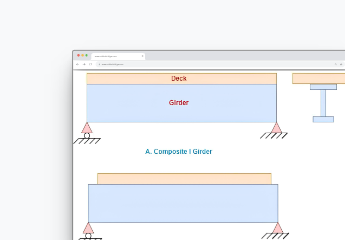The Reality: Difficulty in Integrating Classroom Learning into Practical Design
Recent surveys indicate that 78% of civil engineering graduates in the United States felt that what they learned in school didn't translate well into practical application. Why is there such a disparity between academia and real-world practice? The primary reason is that while universities predominantly focus on 2D-based mechanics, practical design involves considering various load combinations and complex structures.

Design engineers aren't just creators of aesthetically pleasing structures; they're guardians of safety and functionality, responsible for ensuring that every landmark stands not just as a testament to architectural beauty but also as a monument to safety and reliability.
Hence, the limitations of relying solely on 2D mechanics learned in academia become apparent. Real-world structural design requires consideration of myriad loads and iterative processes to determine a structure's ability to withstand these loads. So, practical experience with software used in industry becomes very important.
However, the cost of licensing can be prohibitive for universities with limited budgets, with academic licenses averaging several thousand dollars per license. Consequently, acquiring sufficient licenses for all students becomes challenging. As a result, requests for academic licenses flood our official website.
MIDAS IT Launches Future Engineers Project for Students!
Students have long requested free access to MIDAS software to familiarize themselves with tools essential for practical use. The Future Engineers Project, a free distribution initiative, was launched in response to the needs of students and educators.

 The Future Engineers Project, initiated in early 2023, aims to be a sturdy supporter akin to Iron Man's J.A.R.V.I.S. for university students aspiring to become civil and structural engineers worldwide. Through this project, MIDAS IT seeks to support students majoring in civil and structural engineering globally to become competent engineers contributing to society.
The Future Engineers Project, initiated in early 2023, aims to be a sturdy supporter akin to Iron Man's J.A.R.V.I.S. for university students aspiring to become civil and structural engineers worldwide. Through this project, MIDAS IT seeks to support students majoring in civil and structural engineering globally to become competent engineers contributing to society.

Since its release in 1996, MIDAS IT's software has accompanied over 5,000 global projects. Currently, it is exported to over 100 countries worldwide through 27 overseas branches, including the United States, Japan, China, India, and the United Kingdom. Notably, it is a highly trusted software beloved by senior engineers of global companies such as AECOM, ARUP, and JACOBS.

MIDAS software is used in iconic architectural and structural projects worldwide, including the Burj Khalifa in Dubai, the tallest structure globally, and the Russky Island Bridge in Russia, the longest bridge globally. (For more architectural cases, click ↗️)
Supporting 16,000 Licenses at 62 Universities in North America and the UK in 2023
As a first step, we initiated free support for universities in North America and the UK, where requests from professors and students were most abundant.
Through meetings with professors working in these regions, we learned that many universities in North America and the UK also aspire to utilize MIDAS software. At a school in the eastern United States, students participate in a structural fabrication competition nationwide each year. However, due to the absence of software, they have not efficiently conducted the necessary Trial & Error processes for design. With the free distribution of MIDAS software, they anticipate achieving better results in the competition.
In 2023, we distributed 16,283 licenses to 62 universities, including Purdue University, New York University, and Notre Dame University.
| MIDAS GEN | MIDAS CIVIL | MIDAS GTS NX | MIDAS FEA NX | MIDAS CIM | MIDAS CAD |
| Architecture-specific analysis product | Civil-specific analysis product |
Ground-specific analysis product |
Detailed civil engineering analysis of product | Civil engineering specialized BIM product | 2D CAD product |
| 2963 Lic. | 2892 Lic. | 2919 Lic. | 2589 Lic. | 2480 Lic. | 2440 Lic. |

New York University
.png?width=2016&height=1512&name=MicrosoftTeams-image_(88).png)
Georgia Southern University
.png?width=2776&height=2082&name=MicrosoftTeams-image_(120).png)
Florida Atlantic University
.png?width=4240&height=2384&name=MicrosoftTeams-image_(89).png)
New Jersey Institute of Technology
Real-world Application in Education: Future Engineer License
To facilitate the effective utilization of MIDAS software, we provide educators with comprehensive guides to integrate it into their coursework.
- Comparing Calculations and Software Results of Textbook Example
- Developing Analytical Thinking through Repetitive Exercises
- Enhancement of Students’ Comprehension through Visualization
- Verification of Formulas using MATLAB and Other Software
- Bridge Design Competition

These complimentary licenses are being utilized in various ways, such as:


At the University of Massachusetts Lowell, Professor TzuYang Yu expressed gratitude for the opportunity for students to gain practical experience, previously hindered by a lack of licenses.
.png?width=978&height=908&name=MicrosoftTeams-image_(90).png)
Expanding Globally in 2024
The success of our initiatives has inspired us to expand our reach further in 2024, aiming to provide free access to MIDAS software to more countries and institutions. Additionally, ongoing communication with educators has underscored the need for additional educational resources, beyond the approximately 30 lectures currently available.
Our mission is to empower students to become competent engineers who contribute to the future of our cities and societal infrastructure. We anticipate taking the first step towards this vision in March 2024, with the global rollout of the Academic Software Free Distribution Program.
For further information, please refer to our Future Engineers Project catalog.
See the Catalog in more detail

 Get Started midas Civil
Get Started midas Civil
 Featured blog of this week
Featured blog of this week




/Sungjin%20Jo%20240_240.png)





